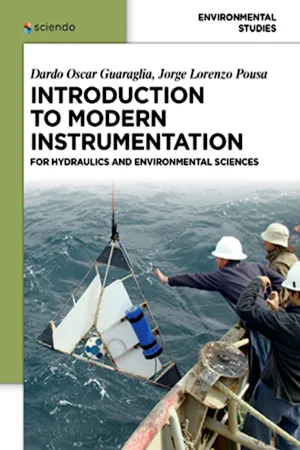Physics
Period, Frequency and Amplitude
Period, frequency, and amplitude are fundamental concepts in the study of waves and oscillations. The period refers to the time it takes for a wave to complete one full cycle, while frequency measures the number of cycles per unit of time. Amplitude, on the other hand, represents the maximum displacement of a wave from its equilibrium position.
Written by Perlego with AI-assistance
Related key terms
Related key terms
1 of 4
Related key terms
1 of 3
7 Key excerpts on "Period, Frequency and Amplitude"
- eBook - ePub
- Mahbub Hassan(Author)
- 2022(Publication Date)
- CRC Press(Publisher)
cycle.Frequency is measured in cycles/sec or Hertz or simply Hz. For example, if a wave completes 1 cycle per sec, like the wave shown in Fig. 2 (a), then it has a frequency of 1 Hz. On the other hand, the wave in Fig. 2 (c) has a frequency of 2 Hz.Phase is the amount of shift from a given reference point. For example, if we consider zero amplitude as our reference point, then the waves that start at zero while gaining their amplitudes, like most of the cases in Fig. 2 , then their phase is zero. The maximum phase shift is 360°, i.e., if the wave is shifted by 360°, then its phase is back to zero again. For example, in Fig. 2 (d), the phase is shifted by 45°. Usually, the phase is measured in radians, where 360° = 2π radian. Therefore, a 45° phase in radian would be π/4.1.1 2D Representation of Phase and Amplitude
The phase can be represented on a 2D graph. A sine wave can be decomposed into its sine and cosine parts. For example, a sine wave with a phase of 45°, can be written as the summation of two parts:(1)sin ( 2 π f t +π 4) = sin(cos (2 π f t)π 4) + cos(sin (2 π f t)π 4)=1sin2(+2 π f t)1cos2(2 π f t)The first part is called the In-phase component I, and the second part, the Quadrature component Q. In this case, we haveI =I and Q are then plotted in a 2D graph as shown in Fig. 3 . In this figure, the x-axis is sine and the y-axis cosine. With1a n d Q =21.2I =we get a single point in the graph, which has a length (amplitude) of1a n d Q =21,21 ( =and an angle (phase) of 45°.) ,I 2+Q 2Fig. 3. Phase and amplitude representation of sin(2πft + π/4) in I-Q graph.1.2 Wavelength
Waves propagate through space and cover distances over time. The distance occupied by one cycle is called the wavelength of the wave and is represented by 2. This is the distance between two points of corresponding phase in two consecutive cycles, as shown in Fig. 4 - eBook - ePub
Sound FX
Unlocking the Creative Potential of Recording Studio Effects
- Alex Case(Author)
- 2012(Publication Date)
- Routledge(Publisher)
frequency. Period is the time it takes for exactly one cycle to occur, with units of seconds per dimensionless cycle, or simply seconds. Frequency describes the number of cycles that occur in exactly one second, with units of dimensionless cycles per second. Therefore, units for frequency live entirely in the denominator (per second, or /s) and have been given the alternative unit of hertz (Hz).Note that counting the number of cycles per second (frequency) is the opposite of counting the number of seconds per cycle (period). Mathematically, they are reciprocals: andwhere f = frequency, and T = period.1.3 Amplitude versus DistanceThe springiness of air ensures that any localized changes in air pressure near a sound source will cause a chain reaction of air pressure changes, above and below the current air pressure, all around that source. Even a slight disturbance of air pressure will ripple outward. In order to describe the state of air pressure along some distance, a different pair of axes is needed: air pressure versus location or air pressure versus distance.At a fixed instant in time, a plot is made of the air pressure as a function of its location in space. Figure 1.5 shows such a snapshot. Returning to Figure 1.1(a) , where an illustrator strategically failed to label any axes, one can conclude that the curves radiating outward from the sound source might be amplitude versus time or amplitude versus distance. The rings of Figure 1.1(b) present sound in a slightly different way. This familiar sketch of sound is a snapshot of amplitude versus distance, showing just the positive peaks of a propagating wave, or just the negative excursions, or just the zero crossings. Called isobars - eBook - ePub
The Speech Chain
The Physics And Biology Of Spoken Language
- Dr. Peter B. Denes, Dr. Elliot N. Pinson(Authors)
- 2016(Publication Date)
- Hauraki Publishing(Publisher)
frequency of the oscillation. If 15 complete cycles occur in one second, we say that the vibration has a frequency of 15 cycles per second (abbreviated, cps). The sound waves we will be interested in have frequencies ranging from tens to thousands of cycles per second.The time taken to complete one cycle of vibration is called the period of the vibration. There is a simple relationship between the frequency of an oscillation and its period. The frequency is simply 1 divided by the period; for example, if the period is 1 /20 of a second, the frequency is 20 cps.So far, we have more or less assumed that, once set into motion, the spring-mass combination would continue to vibrate indefinitely with the same amplitude. This type of motion is displayed graphically in Fig. 3.2(a). Here, we show the motion of a spring-mass system that vibrates with a period of two seconds. Initially, the mass is displaced a distance of one inch and released. After its initial displacement, the mass continues to move back and forth between the extremes of its displacement, one inch on either side of its rest position. Consequently, the amplitude of vibration is one inch.In actual fact, the amplitude of vibration will steadily decrease because of energy losses in the system (due to friction, etc.). Vibrations whose amplitudes decay slowly are said to be lightly “damped,” while those whose amplitudes decay rapidly are heavily “damped.” Figs. 3.2(b) and 3.2(c) show damped oscillations; the damping is greater in Fig. 3.2(c).We will find that the pressure variations that correspond to many interesting acoustic signals—speech waves, for example—are much more complex than the simple shape shown in Fig. 3.2(a). Nonetheless, we frequently find it convenient to discuss vibrations of this particular form; they are called sinusoidal - Mary P Attenborough(Author)
- 2003(Publication Date)
- Newnes(Publisher)
t + ϕ) can be rewritten asy = A ? cos ?(2 π ? f t + ϕ)using the frequency. As f = 1/t , this can be written asy = A ? cos ?()t + ϕ2 πτExample 5.5
(a)y = 3 cos(t + 1); find the amplitude, frequency, period, angular frequency, and phase where t is expressed in seconds.Compare y = 3 cos(t + 1) with y = A cos(ωt + ϕ). Then we can see that the angular frequency ω = 1, the phase ϕ = 1, and the amplitude A = 3. As the frequency, f = ω/2π, f = 1/2π, and the period τ = 1/f = 1/(1/2π) = 2π s.(b)V = 12 cos(314t + 1.6); find the amplitude, frequency, period, angular frequency, and phase where t is expressed in seconds.Compare V = 12 cos(314t + 1.6) with V = A cos(ωt + ϕ). Then the angular frequency, ω = 314, the phase ϕ = 1.6, and the amplitude A = 12. As f = ω/2π, f = 314/2π ≈ 50 Hz, and the period τ = 1/f = 1/50 = 0.02 s.Sinusoidal functions of distance: amplitude, cycle rate, wavelength, and phase
Waves that give the displacement from a central fixed position of various different points at a fixed moment in time can be represented by an expression such as y = A cos(kx +ϕ) or y = A sin(kx +ϕ), where x is in metres. Examples include the position of a vibrating string at a particular moment or the surface of pond in response to a disturbance. As we saw in the previous section, A represents the wave amplitude; k is called the wavenumber and represents the number cycles in 2π. The spatial frequency gives the number of cycles in 1 m (= k /2π). The cycle length is called the wavelength- eBook - ePub
- Marshall Long(Author)
- 2014(Publication Date)
- Academic Press(Publisher)
2Fundamentals of Acoustics
Abstract
Chapter 2 covers the fundamental concepts of acoustical engineering including sound waves, frequency and wavelength, simple harmonic motion, superposition of waves, phase relationships, sound velocity, sound levels, and the characterization of sound sources. The fundamental equations concerning these concepts are presented in the chapter along with a more detailed discussion of propagation of sound in free space. This latter discussion includes details of the spherical spreading of sound from point sources including factors such as directionality, directivity, and directivity index. The chapter ends by modeling line sources (one-dimensional sounds sources) and planar sources (two-dimensional, large, flat surfaces).Keywords
sound pressure ; sound level ; decibel (dB) ; sound power ; velocity of sound ; particle velocity ; impedance ; directivity ; sensitivity ; sources2.1 .Frequency and WavelengthFrequency
A steady sound is produced by the repeated back and forth movement of an object at regular intervals. The time interval over which the motion recurs is called the period . For example if our hearts beat 72 times per minute, the period is the total time (60 seconds) divided by the number of beats (72), which is 0.83 seconds per beat. We can invert the period to obtain the number of complete cycles of motion in one time interval, which is called the frequency :f = frequency (cycles per second or Hz) T = time period per cycle (s) The frequency is expressed in units of cycles per second, or Hertz (Hz), in honor of the physicist Heinrich Hertz (1857–1894).(2.1)whereWavelength
Among the earliest sources of musical sounds were instruments made using stretched strings. When a string is plucked it vibrates back and forth and the initial displacement travels in each direction along the string at a given velocity. The time required for the displacement to travel twice the length of the string is(2.2) - eBook - ePub
- John Watkinson(Author)
- 2013(Publication Date)
- Routledge(Publisher)
In the case of a transient sound caused by an impact, the observer will detect a single replica of the original as it passes at the speed of sound. In the case of the tuning fork, a periodic sound source, the pressure peaks and dips follow one another away from the source at the speed of sound. For a given rate of vibration of the source, a given peak will have propagated a constant distance before the next peak occurs. This distance is called the wavelength lambda. Figure 2.2 shows that wavelength is defined as the distance between any two identical points on the whole cycle. If the source vibrates faster, successive peaks get closer together and the wavelength gets shorter. Figure 2.2 also shows that the wavelength is inversely proportional to the frequency. It is easy to remember that the wavelength of 1000 Hz is a foot (about 30 cm). 2.3 Periodic and aperiodic signals Sounds can be divided into these two categories and analysed both in the time domain in which the waveform is considered, or in the frequency domain in which the spectrum is considered. The time and frequency domains are linked by transforms of which the best known is the Fourier transform. Transforms will be considered further in Chapter 3. Figure 2.3 (a) shows that an ideal periodic signal is one which repeats after some constant time has elapsed and goes on indefinitely in the time domain. In the frequency domain such a signal will be described as having a fundamental frequency and a series of harmonics or partials which are at integer multiples of the fundamental. The timbre of an instrument is determined by the harmonic structure. Where there are no harmonics at all, the simplest possible signal results which has only a single frequency in the spectrum. In the time domain this will be an endless sine wave. Figure 2.3 (b) shows an aperiodic signal known as white noise - eBook - ePub
- Dardo Oscar Guaraglia, Jorge Lorenzo Pousa(Authors)
- 2015(Publication Date)
- De Gruyter Poland(Publisher)
Fig. 3.1: A sinusoidal wave as a function of x. The amplitude (A) and the wavelength (λ) are shown.3.3 Harmonic Sound Waves
These waves are generated by a mechanical source vibrating with a simple harmonic motion, like a tuning-fork. The vibrating focus makes nearby air molecules oscillate about their equilibrium positions.These molecules collide with their neighbors, spreading the sound wave. The displacement of the molecules s(x, t) as function of space x and time t is given bywhere s0 is the maximum displacement of a molecule about its equilibrium position (amplitude); l is the wavelength (distance between two successive peaks); f is the number of peaks that pass through a point per unit time, called the frequency; T is the period (T = 1/f) and k is the wave number.For a sinusoidal wave there is a relationship between frequency (f), wavelength (λ) and velocity (c),Because of the motion of particles, there are regions in the medium where the particles are compressed together and other regions where they are spread apart. These regions are known as compressions and rarefactions, respectively. The compressions are regions of high pressure whereas the rarefactions are regions of low pressure. Sound waves produce fluctuations of pressure above and below the atmospheric pressure. The pressure wave has the same waveform as the displacement one, but is delayed by π/2. Sound waves are longitudinal waves because they transfer energy in the same direction as the pressure and displacement disturbances.Particle compressions and rarefactions are shown at the top of Figure 3.2 , whereas their associated displacement and pressure waveforms are illustrated at the bottom.The speed of sound (c) is the speed at which the wave propagates. It depends on the properties of the medium, e.g. for air ca = 343 m/s and for water cw
Index pages curate the most relevant extracts from our library of academic textbooks. They’ve been created using an in-house natural language model (NLM), each adding context and meaning to key research topics.
Explore more topic indexes
Explore more topic indexes
1 of 6
Explore more topic indexes
1 of 4






